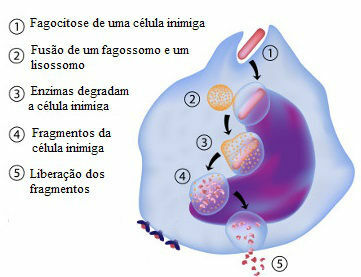Some substances enter the cell via active and passive transport, others, however, are not able to use this transport route. In these cases, they can be engulfed by the cell in a process known as endocytosis.
One type of endocytosis is called phagocytosis. In this process, the cell captures a relatively large solid particle through cytoplasmic processes called pseudopods. The particle is then engulfed and becomes part of the cell's cytoplasm. At this stage, the ingested material is completely surrounded by a membrane, forming the so-called phagosome.
Inside the phagosome, enzymes are released that degrade the ingested particle, which can be a micro-organism or even cell debris. These enzymes are released by organelles called lysosomes, which join the phagosome to form a digestive vacuole. Material that is not digested is called residual bodies, which, after some time, can be excreted by the cell.
Note the following diagram that illustrates the phagocytosis process:

Observe the steps of the phagocytosis process
Among the cells capable of phagocytosis, some species of protozoa, such as amoebas, can be highlighted. They launch pseudopods towards their food to capture it, the process being, therefore, fundamental for the nutrition of these beings.
In vertebrates, cells are found that perform the function of phagocytizing invading microorganisms, actively acting in the defense of our organism and fighting infections. Neutrophils act by actively destroying disease-causing microorganisms as well as other foreign substances through the process of phagocytosis. In addition, there are macrophages, cells with great phagocytic power, which, in addition to phagocytose pathogenic particles, destroy old cells in our body, thus contributing to the cleaning of the body.
By Ma. Vanessa dos Santos
Source: Brazil School - https://brasilescola.uol.com.br/o-que-e/biologia/o-que-e-fagocitose.htm
